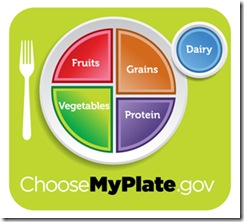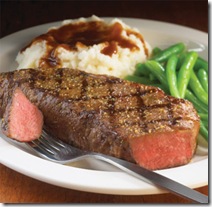 It seems everyone is all a-twitter about the USDA’s new nutrition icon MyPlate, which replaced MyPyramid. Personally, I think anything would be an improvement over the nutrition pyramid which, as my young daughter put it, had “all the food piled up at the bottom, and you can’t tell what group it’s in”. I never found it to be a useful teaching tool. The plate, by contrast, is a decent visual teaching tool that can help people gain an understanding of what a healthy balance of foods from various food groups looks like. In truth, Registered Dietitians have used similar plate models for years (I have several versions in my office that I use with various patients). The simplified version I often use is a plate on which 1/2 the food is vegetables and/or salad, 1/4 is meat/protein, and 1/4 is a starch (grain, bread, pasta or starchy vegetables). I do value fruit, but I just tend to help people build fruit into snacks and specific meals so that they don’t have to be concerned about having both fruits & veggies at all meals. There are many ways to achieve balanced eating, but the MyPlate model is a good example, and a step in the right direction. The MyPlate model is not going to be a perfect fit for everyone. Those who already have a healthy diet and lifestyle need not fine-tune their diet to resemble the MyPlate model exactly. On the other hand, for the majority of people in the US, the MyPlate model can be helpful in identifying the need to increase consumption of fruits & veggies, and limit meat portions. By doing so, they will reap the many health benefits of eating more fruits & veggies (see my Nutrition Challenge posts for more on this).
It seems everyone is all a-twitter about the USDA’s new nutrition icon MyPlate, which replaced MyPyramid. Personally, I think anything would be an improvement over the nutrition pyramid which, as my young daughter put it, had “all the food piled up at the bottom, and you can’t tell what group it’s in”. I never found it to be a useful teaching tool. The plate, by contrast, is a decent visual teaching tool that can help people gain an understanding of what a healthy balance of foods from various food groups looks like. In truth, Registered Dietitians have used similar plate models for years (I have several versions in my office that I use with various patients). The simplified version I often use is a plate on which 1/2 the food is vegetables and/or salad, 1/4 is meat/protein, and 1/4 is a starch (grain, bread, pasta or starchy vegetables). I do value fruit, but I just tend to help people build fruit into snacks and specific meals so that they don’t have to be concerned about having both fruits & veggies at all meals. There are many ways to achieve balanced eating, but the MyPlate model is a good example, and a step in the right direction. The MyPlate model is not going to be a perfect fit for everyone. Those who already have a healthy diet and lifestyle need not fine-tune their diet to resemble the MyPlate model exactly. On the other hand, for the majority of people in the US, the MyPlate model can be helpful in identifying the need to increase consumption of fruits & veggies, and limit meat portions. By doing so, they will reap the many health benefits of eating more fruits & veggies (see my Nutrition Challenge posts for more on this).
Last week, before the news of the new MyPlate icon broke, I was contemplating the proportions served at restaurants. Admittedly, I don’t eat out very often (maybe a couple times a month, if that), but last week I had two meals out –one at a nice restaurant and one with a friend in the dining room of an assisted living home. I was struck that in both places most of the plate was taken up by the protein portion of the meal. At the nice restaurant I ordered a NY steak with grilled asparagus and potatoes au gratin with goat cheese. The meal was plated rather fancily with a small serving of potatoes au gratin (less than 1/2 cup) carefully stacked like poker chips in the middle of the plate, about 4 pieces of grilled asparagus neatly layered next, and then 2 thinly sliced pieces of steak artfully laid across it all – hiding the vegetables. In this case, the only thing I saw when my plate was presented was the steak (about 8 oz.).At the assisted living facility I had my choice of ordering steak or fish (cod, I think), and had a choice of baked potato, rice, green beans and/or asparagus for “sides”. I was planning on doing a long bike ride the next day so was looking for extra carbs. I ordered the fish, a vegetable and a double portion of rice. Once again, the protein  portion trumped all. The fish took up over 1/2 my plate and the “double portion of rice” took up about 1/4 of the plate, as did the veggies. Presentation was not as important at this dining hall, but there is an assumption that the nutritional needs of the residents should be. I pondered how Americans have come to see meat as the central part of the meal, and consider everything else to be “sides”. In so many other parts of the world, grains and vegetables make up the majority of a meal meat is what is considered more of a garnish (if present at all). My how we have evolved in our Western “civilization”!
portion trumped all. The fish took up over 1/2 my plate and the “double portion of rice” took up about 1/4 of the plate, as did the veggies. Presentation was not as important at this dining hall, but there is an assumption that the nutritional needs of the residents should be. I pondered how Americans have come to see meat as the central part of the meal, and consider everything else to be “sides”. In so many other parts of the world, grains and vegetables make up the majority of a meal meat is what is considered more of a garnish (if present at all). My how we have evolved in our Western “civilization”!
It makes me question what “normal” looks like on the plates of most Americans. I have the image of the 1/2 vegetable, 1/4 starch, 1/4 meat plate in my head and roughly follow that pattern at home. However, I know that many of my patients and clients eat out several times a week, and I can’t help wonder if their perception of a “normal” dinner plate is one which is predominately meat. Are restaurants influencing the perception of the customers or just catering to a pre-existing perception? Who knows? I do think it would be interesting, however to request a MyPlate proportioned meal at restaurants. I wonder what would happen? I’m guessing I’d be met by a blank stare. The explanation would be easy enough: “Just give me a serving of meat/fish about the size of the palm of my hand, a serving of starch (rice, potato, pasta, etc.) about the size of my fist, and fill the rest of the plate with vegetables.” Given the size of many restaurant plates, that could be a LOT of veggies! Ok by me…I’d be in vegetable heaven (as long as I had them hold the butter and sauces). As most restaurant portions currently stand, even ordering a double order of veggies is not likely to trump the meat portion. So I challenge you to have a little fun next time you eat out and request a MyPlate proportioned meal. At the very least, it could be somewhat amusing… and at best, you could be improving your health, helping to educate the restaurant employees, and re-shaping the way America thinks about balanced eating. Bon Apatite!
stand, even ordering a double order of veggies is not likely to trump the meat portion. So I challenge you to have a little fun next time you eat out and request a MyPlate proportioned meal. At the very least, it could be somewhat amusing… and at best, you could be improving your health, helping to educate the restaurant employees, and re-shaping the way America thinks about balanced eating. Bon Apatite!


You said, “…I can’t help wonder if their perception of a “normal” dinner plate is one which is predominately meat.” Why would you wonder? *Of course* that is the perception of the average American. Have you EVER seen a menu that offered a salad with a side steak, chips and fish, or a tomato, lettuce and bacon sandwich? I’d bet you could spend your career in a pizza joint and never hear anyone ask for a “peppers, onion, cheese and pepperoni” pizza. It seems telling that menus are typically divided by animal protein types: Beef, Pork, Chicken, Fish, and, Dessert; oh yeah, and Salads and Sides.